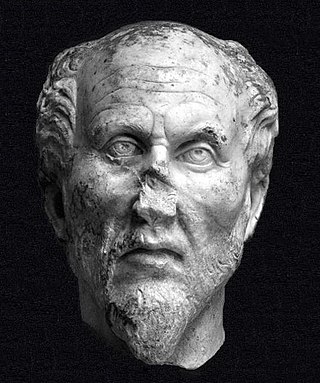Related Research Articles
In the Platonic, Neopythagorean, Middle Platonic, and Neoplatonic schools of philosophy, the demiurge is an artisan-like figure responsible for fashioning and maintaining the physical universe. The Gnostics adopted the term demiurge. Although a fashioner, the demiurge is not necessarily the same as the creator figure in the monotheistic sense, because the demiurge itself and the material from which the demiurge fashions the universe are both considered consequences of something else. Depending on the system, they may be considered either uncreated and eternal or the product of some other entity.

Gnosticism is a collection of religious ideas and systems that coalesced in the late 1st century AD among Jewish and early Christian sects. These various groups emphasized personal spiritual knowledge (gnosis) above the proto-orthodox teachings, traditions, and authority of religious institutions. Gnostic cosmogony generally presents a distinction between a supreme, hidden God and a malevolent lesser divinity who is responsible for creating the material universe. Consequently, Gnostics considered material existence flawed or evil, and held the principal element of salvation to be direct knowledge of the hidden divinity, attained via mystical or esoteric insight. Many Gnostic texts deal not in concepts of sin and repentance, but with illusion and enlightenment.

Plotinus was a Greek Platonist philosopher, born and raised in Roman Egypt. Plotinus is regarded by modern scholarship as the founder of Neoplatonism. His teacher was the self-taught philosopher Ammonius Saccas, who belonged to the Platonic tradition. Historians of the 19th century invented the term "neoplatonism" and applied it to refer to Plotinus and his philosophy, which was vastly influential during late antiquity, the Middle Ages, and the Renaissance. Much of the biographical information about Plotinus comes from Porphyry's preface to his edition of Plotinus' most notable literary work, The Enneads. In his metaphysical writings, Plotinus described three fundamental principles: the One, the Intellect, and the Soul. His works have inspired centuries of pagan, Jewish, Christian, Gnostic, and early Islamic metaphysicians and mystics, including developing precepts that influence mainstream theological concepts within religions, such as his work on duality of the One in two metaphysical states.
The concept of an Ogdoad appears in Gnostic systems of the early Christian era, and was further developed by the theologian Valentinus.
Emanationism is an idea in the cosmology or cosmogony of certain religious or philosophical systems. Emanation, from the Latin emanare meaning "to flow from" or "to pour forth or out of", is the mode by which all things are derived from the first reality, or principle. All things are derived from the first reality or perfect God by steps of degradation to lesser degrees of the first reality or God, and at every step the emanating beings are less pure, less perfect, less divine. Emanationism is a transcendent principle from which everything is derived, and is opposed to both creationism and materialism.
Valentinus was the best known and, for a time, most successful early Christian Gnostic theologian. He founded his school in Rome. According to Tertullian, Valentinus was a candidate for bishop but started his own group when another was chosen.
Pleroma generally refers to the totality of divine powers. It is used in Christian theological contexts, especially in Gnosticism. The term also appears in the Epistle to the Colossians, which is traditionally attributed to Paul the Apostle. The word is used 17 times in the New Testament.

Iamblichus was an Arab neoplatonic philosopher. He determined a direction later taken by neoplatonism. Iamblichus was also the biographer of the Greek mystic, philosopher, and mathematician Pythagoras. In addition to his philosophical contributions, his Protrepticus is important for the study of the sophists because it preserved about ten pages of an otherwise unknown sophist known as the Anonymus Iamblichi.

The Apocryphon of John, also called the Secret Book of John or the Secret Revelation of John, is a 2nd-century Sethian Gnostic Christian pseudepigraphical text attributed to John the Apostle. It is one of the texts addressed by Irenaeus in his Against Heresies, placing its composition before 180 AD. It is presented as describing Jesus appearing and giving secret knowledge (gnosis) to his disciple John. The author describes it as having occurred after Jesus had "gone back to the place from which he came".
The Sethians were one of the main currents of Gnosticism during the 2nd and 3rd century AD, along with Valentinianism and Basilideanism. According to John D. Turner, it originated in the 2nd century AD as a fusion of two distinct Hellenistic Judaic philosophies and was influenced by Christianity and Middle Platonism. However, the exact origin of Sethianism is not properly understood.
Allogenes is a series of Gnostic texts. The main character in these texts is Allogenes, which translates as 'stranger,' 'foreigner,' or 'of another race.' The first text discovered was Allogenes as the third tractate in Codex XI of the Nag Hammadi library. The Coptic manuscript is a translation of a Greek original, likely written in Alexandria before 300 AD. In this text, containing Middle Platonic or Neoplatonic elements, Allogenes receives divine revelations.
Valentinianism was one of the major Gnostic Christian movements. Founded by Valentinus in the 2nd century AD, its influence spread widely, not just within Rome but also from Northwest Africa to Egypt through to Asia Minor and Syria in the East. Later in the movement's history it broke into an Eastern and a Western school. Disciples of Valentinus continued to be active into the 4th century AD, after the Roman Emperor Theodosius I issued the Edict of Thessalonica, which declared Nicene Christianity as the State church of the Roman Empire.
Numenius of Apamea was a Greek philosopher, who lived in Rome, and flourished during the latter half of the 2nd century AD. He was a Neopythagorean and forerunner of the Neoplatonists.
Gnosticism refers to a collection of religious groups originating in Jewish religiosity in Alexandria in the first few centuries AD. Neoplatonism is a school of Hellenistic philosophy that took shape in the 3rd century, based on the teachings of Plato and some of his early followers. While Gnosticism was influenced by Middle Platonism, neoplatonists from the third century onward rejected Gnosticism. Nevertheless, Alexander J. Mazur argues that many neoplatonic concepts and ideas are ultimately derived from Sethian Gnosticism during the third century in Lower Egypt, and that Plotinus himself may have been a Gnostic before nominally distancing himself from the movement.

The term monad is used in some cosmic philosophy and cosmogony to refer to a most basic or original substance. As originally conceived by the Pythagoreans, the Monad is the Supreme Being, divinity or the totality of all things. According to some philosophers of the early modern period, most notably Gottfried Wilhelm Leibniz, there are infinite monads, which are the basic and immaterial elementary particles, or simplest units, that make up the universe.
Henosis is the classical Greek word for mystical "oneness", "union" or "unity". In Neoplatonism, henosis is unification with what is fundamental in reality: the One, the Source, or Monad. The Neoplatonic concept has precedents in the Greek mystery religions as well as parallels in Eastern philosophy. It is further developed in the Corpus Hermeticum, in Christian theology, Islamic Mysticism, soteriology and mysticism, and is an important factor in the historical development of monotheism during Late Antiquity.
The Tripartite Tractate is a Valentinian Gnostic work. The date is estimated to the second half of the third century or the fourth century but is "most likely based on an earlier Greek version." It is the second-longest text in the Nag Hammadi library. It is the fifth tractate of the first codex, known as the Jung Codex. It is untitled, and instead it gets its name "from the fact that the ancient copyist divided the text with decorative markings in two places, thus separating the tractate into three parts." The first part describes the relationship between the Father, the Logos, the Church, and the aeons. The second part contains the Gnostic creation narrative, in which man is created by the Demiurge and is a mixture of both spiritual and material substances. The third part explains the Savior's role in salvation.
Neoplatonism was a major influence on Christian theology throughout Late Antiquity and the Middle Ages in the East, and sometimes in the West as well. In the East, major Greek Fathers like Basil, Gregory of Nyssa and Gregory of Nazianzus were influenced by Platonism and Neoplatonism, but also Stoicism often leading towards asceticism and harsh treatment of the body, for example stylite asceticism. In the West, St. Augustine of Hippo was influenced by the early Neoplatonists Plotinus and Porphyry. Later on, in the East, the works of the Christian writer Pseudo-Dionysius the Areopagite, who was influenced by later Neoplatonists such as Proclus and Damascius, became a critical work on which Greek church fathers based their theology, like Maximus believing it was an original work of Dionysius the Areopagite.
Neoplatonism is a version of Platonic philosophy that emerged in the 3rd century AD against the background of Hellenistic philosophy and religion. The term does not encapsulate a set of ideas as much as a series of thinkers. Among the common ideas it maintains is monism, the doctrine that all of reality can be derived from a single principle, "the One".
In many Gnostic systems, various emanations of God are known by such names as One, Monad, Aion teleos, Bythos, Arkhe, Proarkhe and as Aeons. In different systems these emanations are differently named, classified, and described. In Basilidian Gnosis they are called sonships ; according to Marcus, they are numbers and sounds; in Valentinianism they form male/female pairs called syzygies.
References
- ↑ Francis E. Peters Greek Philosophical Terms: A Historical Lexicon 1970 p. 42.
- ↑ Louis P. Pojman, "Valentinus," in The Cambridge Dictionary of Philosophy, 3rd ed., ed. Robert Audi.
- ↑ Louis P. Pojman, "gnosticism," in The Cambridge Dictionary of Philosophy, 3rd ed., ed. Robert Audi.
- ↑ "The Apocryphon of John - Frederik Wisse - the Nag Hammadi Library".
- ↑ Diogenes Laërtius, Lives and Opinions of Eminent Philosophers .
- ↑ Mead, G.R.S. 1900. "Epiphanes, Fragments of a Faith Forgotten, pp. 232–235, available online by The Gnostic Society Library.